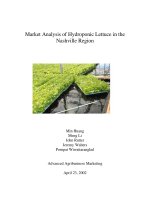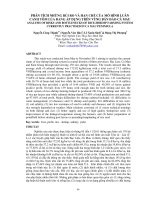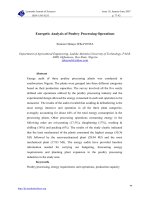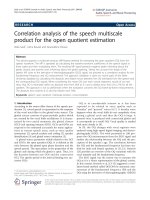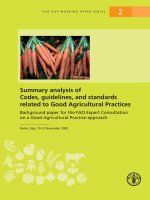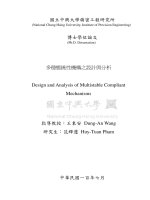Correlation analysis of socio-demographic profile of dairy farmers with knowledge and adoption of animal husbandry practices
Bạn đang xem bản rút gọn của tài liệu. Xem và tải ngay bản đầy đủ của tài liệu tại đây (216.07 KB, 8 trang )
Int.J.Curr.Microbiol.App.Sci (2017) 6(3): 1918-1925
International Journal of Current Microbiology and Applied Sciences
ISSN: 2319-7706 Volume 6 Number 3 (2017) pp. 1918-1925
Journal homepage:
Original Research Article
/>
Correlation Analysis of Socio-Demographic Profile of Dairy Farmers with
Knowledge and Adoption of Animal Husbandry Practices
G.J. Panchbhai1, M.F. Siddiqui2, M.N. Sawant3*, A.P. Verma4 and J. Parameswaranaik5
1
Department of Livestock Production and Management, Post Graduate Institute of
Veterinary and Animal Sciences (MAFSU), Akola-444104, India
2
Department of Livestock Production and Management, College of Veterinary and
Animal Sciences (MAFSU), Parbhani-431402, India
3
Department of Veterinary and Animal Husbandry Extension, Bombay Veterinary College,
(MAFSU) Parel, Mumbai -12, India
4
Dairy Extension Division, ICAR-National Dairy Research institute, Karnal-132001 (Haryana)
*Corresponding author
ABSTRACT
Keywords
Socio-demographic
profile, Dairy
farmers,
Knowledge,
Adoption, Animal
husbandry practices.
Article Info
Accepted:
24 February 2017
Available Online:
10 March 2017
Dairy farming in India plays a vital role in livelihood security of the dairy farmers. The
factors which are major hurdles in increasing farmers income are low productivity of
indigenous breeds, inadequate knowledge about balanced feeding and low conception rate
through artificial insemination. The present study was conducted in Solapur district of
Maharashtra state with the objective of correlational analysis of socio-demographic profile
of dairy farmers with knowledge and adoption of animal husbandry practices. Data were
randomly collected from a total of 200 dairy farmers from 10 villages. The ex-post facto
research design of social science was used for the present investigation. The findings of the
study revealed that 72.00 % and 67.50% respondents had medium knowledge and adoption
level of dairy animal husbandry practices. On correlation analysis of socio-demographic
profile of dairy farmers with knowledge level, it was found that education, herd size,
sources of information were found to be positive and highly significant relationship
(P<0.01) and social participation was found positive significant (p<0.05) with knowledge.
Findings regarding relationship between adoption of dairy animals management practices
shown that, social participation exerted highest positive correlation coefficient (P<0.01)
with extent of adoption of dairy animals management practices. Characteristics like
education, herd size and source of information had positive significant relationship
(P<0.05) with extent of adoption.
Introduction
Dairy industry in India has made a significant
progress in the last three decades with
unprecedented growth in milk production and
per capita milk availability. Cattle and buffalo
produce milk which is the largest agricultural
commodity, plays a major role in Indian
economy. India is one of the countries which
has modernized its dairying and has achieved
higher production through the introduction of
scientific technologies into dairy farming
system (Khayali et al., 2015). It is recognized
that if progress has to be achieved in dairy
farmers, they are to be modernized in
knowledge, adoption and their personal,
1918
Int.J.Curr.Microbiol.App.Sci (2017) 6(3): 1918-1925
social and economic characteristics should be
improved (Surkar et al., 2014). India has
emerged as leading milk producer country in
the world, however production potential per
milking animal is very low i.e. with average
in indigenous cows, crossbred cows and
buffalo are 1.98, 6.75 and 4.50 kg/day
respectively (Hegde, 2006). This low
production in India is mainly due to lack or
low level of adoption of the dairy farmers
about improved animal husbandry practices
which make differences in socioeconomic
conditions. In these contexts, the present
study was undertaken to know the sociodemographic profile of dairy farmers and its
relationship with knowledge and adoption of
animal husbandry practices.
Materials and Methods
The present study was conducted at dairy cooperative “Shivamrut Dudh Utpadak Sahakari
Sangh Maryadit” place Akluj of Solapur
district of Maharashtra State. Majority of the
area was irrigated and had large population of
crossbred cattle and buffaloes. There were
117 villages connected to the co-operative
and 371 primary milk co-operatives were
working in this area with daily milk collection
of 1, 80,000 litres. Ten villages were selected
for the study from 117 villages from the
jurisdiction of co-operative on the basis of
random sampling. Villages from irrigated
part, partially irrigated and dry part of the area
were selected to have composite sample for
study. Twenty member producers of dairy cooperative were selected as respondents from
each village with the help of random
sampling. Thus a total of 200 dairy farmers
were selected from 10 villages as sample.
During selection of respondents due care was
taken to ensure that they were evenly
distributed in the village and truly represent
animal management practices prevailing in
the study area. Selected respondents were
interviewed and the desired information was
collected with the help of pre-tested interview
schedule. The ex-post facto research design of
social science was used for the present
investigation. Data were tabulated and
analysed with various statistical tools like
frequency, percentage and correlation
analysis.
Results and Discussion
Socio-demographic profile of dairy farmers
The study revealed that majority of the dairy
farmers (68.00%) belonged to middle age
group and it was found that 38.50, 20.50 and
20 per cent of the respondents were educated
upto high school followed by middle school
and primary school level, respectively, while
3.50 per cent of the respondents had
education upto graduation level. These
findings are in line with the results of Gautam
et al., (2007) and contrary to the results of
Aulakh et al., (2011) and Lohakare et al.,
(2013). The majority of the respondents
(77.00%) were from medium family size and
most of the respondents (58.50%) possessed
4-7 dairy animals followed upto 3 (29.50%)
and large above 8 animals (12.00%),
respectively. The probable reason behind
medium herd size of the most of the
respondents might be that dairy farmer
members are trying to increase their herd size.
These results are in agreement with the results
of Senthilkumar et al., (2006). It was
observed that from Table 1 that 35.00 per cent
of respondents’ belonged to small farmers
category, 22.50 per cent of respondents
belonged to the category of marginal and
19.50 per cent to the category of medium
farmers. Only 19.00 per cent farmers
belonged to large category and 4.00 per cent
farmers were landless, respectively. These
findings are in agreement with the findings of
Verma et al., (2016) who also reported that
majority of respondents were small and
marginal. The result presented in table 1
indicated that majority of the respondents
(46.50%) were in medium income group
1919
Int.J.Curr.Microbiol.App.Sci (2017) 6(3): 1918-1925
followed by low income (27.00%) and high
income (26.50%), respectively. The probable
reason might be majority of respondents were
co-operative member producers which has
attributed to the major share of income
coming from dairy business coupled with
agricultural farming.
It was also observed that 36.50 per cent of
respondents belonged to the category of high
social participation followed by 35.00 per
cent under medium and 28.50 per cent of the
respondents
were
from
low
social
participation category. The above findings are
in contrary with the findings of Tomar et al.,
(2016) who reported majority of the
respondent were medium social participation.
More than two-third (90.50%) had used the
medium sources of information while, 7.50
and 2.00 per cent of the respondents had used
high and low level of sources of information.
It could be due to the organization of
livestock campaigns, tours, kisan call centres,
exhibition, strong network of technical and
field staff of co-operative and the free and
common access to the electronic media.
When risk orientation was considered,
71.50% belonged to medium risk orientation
category followed by 20.00 per cent from
high and only 8.50 per cent of the respondents
reported low risk orientation category.
Accepting the challenges and dared decisions
of adopting new technological innovations
regarding the various animal husbandry
practices were the results of medium to high
risk orientation categories observed in the
present study of the member producers of cooperative. Regarding annual income, 71.50
and 20.00% were under medium to high
annual income (1,01,000 to 2, 50,000)
categories. The low risk orientation (8.50 per
cent) observed in the present study may be
from the member producers with low annual
income category whose attitude is on the safer
side of accepting the risk with adoption of
new animal husbandry practices. These
results are similar with the findings of Verma
et al., (2016).
Knowledge level of dairy farmers on
animal husbandry practices
A perusal of the table 2 reveals that, 72.00 per
cent respondent had medium whereas 17.50
per cent had high and 10.50 per cent
respondents possessed low knowledge level
on animal husbandry practices. The
knowledge level of respondents observed in
the present study was restricted to only animal
husbandry practices well acquainted and
adopted by the respondents. The majority of
the farmers had medium to high level of
knowledge may be indicative of the fact that
social participation, education level, use of
sources of information and experience
combined with co-operative dairy business
must have played a pivotal role in upgrading
their knowledge level regarding the animal
husbandry practices. The findings of the
present study are in conformity with
Satyanarayan and Jagadeeswary (2010) who
also reported that majority of dairy farmers
(73.00%) possessed medium knowledge
followed by high (16.00%) and low (11.00%)
knowledge levels on recommended animal
husbandry practices. Rahman and Gupta
(2015) also reported that majority of members
(38.00 per cent) had medium level of
knowledge (48.87-56.38) on improved dairy
farming practices. Similar findings are also
reported by Biswas et al., (2011).
Adoption of animal husbandry practices by
the respondents
Data furnished in the table no 3 illustrates that
67.50 per cent of respondents had medium
level of adoption of recommended practices
of animal husbandry followed by 19.50 per
cent of respondents under high whereas,
13.00 per cent of respondents had low
adoption level.
1920
Int.J.Curr.Microbiol.App.Sci (2017) 6(3): 1918-1925
Table.1 Socio-demographic profile of the dairy farmers
Sl.No.
1.
(i)
(ii)
(iii)
2.
(i)
(ii)
(iii)
(iv)
(v)
(vi)
(vii)
4.
(i)
(ii)
(iii)
5.
(i)
(ii)
(iii)
(iv)
(v)
6.
(i)
(ii)
(iii)
7.
(i)
(ii)
(iii)
8.
(i)
(ii)
(iii)
9.
(i)
(ii)
(iii)
10.
(i)
(ii)
(iii)
Respondents
Frequency
%
Particulars of Variables
Age (Year)
Young (upto 26 years)
Middle (27 to 49 years)
Old (50 and above years)
Education
Illiterate
Can read only
Can read and write
Primary school
Middle school
High school
Graduate
Family size
Small (up to 3 members)
Medium (4 to 9 members)
Large (10 and above members)
Size of land holding
Landless (No Land)
Marginal (upto 2.5 acres)
Small (above 2.5 to 5 acres)
Medium (above 5 to 10 acres)
Large (above 10 acres)
Annual income
Low (up to Rs.100,000)
Medium (Rs.101,000 to 250,000)
High (Above Rs. 2,50,000)
Herd size
Small (Up to 3 animals)
Medium (4 to 7 animals)
Large (8 and above animals)
Social participation
Low (score up to 9)
Medium (score 10-24)
High (score 25 and above)
Source of information
Low (score up to10)
Medium (score 10 to 18)
High (score 19 and above)
Risk orientation
Low (score up to 20)
Medium (score 21 to 25)
High (score 26 and above)
1921
18
136
46
9.00
68
23
33
01
01
40
41
77
07
16.50
0.50
0.50
20.00
20.50
38.5
3.50
16
154
30
8.00
77.00
15.00
08
45
70
39
38
4.00
22.50
35.00
19.50
19.00
54
93
53
27.00
46.50
26.50
59
117
24
29.50
58.50
12.00
57
70
73
28.50
35.00
36.50
4
181
15
2.00
90.50
7.50
17
143
40
8.50
71.50
20.00
Int.J.Curr.Microbiol.App.Sci (2017) 6(3): 1918-1925
Table.2 Distribution of respondents according to their knowledge level of respondents
Sr. No.
1.
2.
3.
Category
Low (score up to 30)
Medium (score 31 to 39)
High (score 40 and above)
Total
Frequency
21
144
35
200
Per cent
10.50
72.00
17.50
100.00
Table.3 Distribution of respondents according to their adoption of dairy
animals’ management practices
Sr. No.
1.
2.
3.
Category
Low (score up to 68)
Medium (score 69 to 79)
High (score 80 and above)
Total
Frequency
26
135
39
200
Per cent
13.00
67.50
19.5
100.00
Table.4 Relationship between selected characteristics of the respondents with knowledge
Sr. No.
1.
2.
3
4.
5.
6.
7.
8.
9.
Independent variables
Age
Education
Family size
Herd size
Land holding
Annual income
Risk orientation
Social participation
Sources of information
Coefficient of correlation (r)
0.109 NS
0.331**
0.095 NS
0.270**
0.137 NS
0.127 NS
0.027 NS
0.154*
0.248**
**Significant at 1 percent level of probability, *Significant at 5 percent level of probability
NS=Non Significant
Table.5 Association between selected characteristics of respondents with adoption of animal
husbandry practices
Sr. No.
1.
2.
3
4.
5.
6.
7.
8.
9.
Independent variables
Age
Education
Family size
Herd size
Land holding
Annual income
Risk orientation
Social participation
Sources of information
Coefficient of correlation (r)
0.025 NS
0.255*
0.117 NS
0.226*
0.119 NS
0.129 NS
0.050 NS
0.182**
0.254*
**Significant at 1 per cent level of probability, *Significant at 5 percent level of probability; NS=Non-significant
1922
Int.J.Curr.Microbiol.App.Sci (2017) 6(3): 1918-1925
The adoption level of the respondents might
have been increased because of their
experience of dairy business with cooperative pattern of dairy farming. The
findings of the study are also in compliance
with Rahman and Gupta (2015) who reported
that members (47.00%) were found to have
medium adoption level (47.96-54.45) of
improved dairy farming practices (IDFPs).
Relationship between socio-demographic
profiles of respondent with knowledge
Out of 9 variables studied 3 important
variables namely, education, herd size, and
sources of information were highly significant
(P<0.01) with knowledge level while a
significant
relationship
(P<0.05)
was
observed with social participation of dairy
farmers.
The
positive
non-significant
correlation of age, family size, land holding,
annual income, and risk orientation observed
in the present study may be attributed to the
fact that these socio-economic variables
definitely will not have any bearing on the
knowledge level of respondents. The highly
significant positive correlation coefficient of
education, herd size, use of sources of
information and only significant correlation of
social participation with knowledge level of
dairy animal management practices may lead
to conclusion that these socio-economic
independent variables play a pivotal role in
increasing the dependent variable knowledge
of member producers of co-operative. These
results are in agreement with Surkar et al.,
(2014) who explored that there was positive
and highly significant (P<0.01) relationship
between use of sources of information and
knowledge
of
livestock
management
practices, herd size was positively and
significantly correlated with knowledge and
contrast results for coefficient of correlation
for education, family size, herd size, land
holding, annual income and risk orientation
were reported by Arora et al., (2006). The
findings of the study are similar with Rahman
and Gupta (2015) who reported that
educational status and herd size have highly
significant relationship (p<0.01) with
knowledge level of farmers on improved
dairy farming practices.
Association between socio-demographic
profiles of respondents with adoption of
animal husbandry practices
The results in the Table 5 indicate that, out of
the eight selected characteristics of dairy
farmers, social participation exerted highest
positive correlation coefficient (P<0.01) with
extent of adoption of animal husbandry
practices. Variables like education, herd size
and sources of information had positive
significant relationship (P<0.05) with extent
of adoption whereas age, family size, annual
income and risk orientation had positive nonsignificant relationship with extent of
adoption of animal husbandry practices. The
findings of the study are in conformity with
Rahman and Gupta (2015). The findings of
the study are in contrast with Sabapara et al.,
(2016) who reported that social participation
had non-significant relationship with adoption
of improved dairy husbandry practices.
Satyanarayan and Jagadeeswary (2010) also
reported similar results that family size,
annual income and land holding had nonsignificant relationship with extent of
adoption of improved dairy management
practices.
In conclusion dairying is an important part of
Indian agro based economy; it not only
provides but also offers employment
opportunities to the poor and weaker sections
of the society. Now a day’s Indian dairy
industry is at cross roads of industry which
has been dominated by government sector and
working in co-operative mode. So in order to
improve the same an extension agent has to
work on the social participation of the dairy
1923
Int.J.Curr.Microbiol.App.Sci (2017) 6(3): 1918-1925
farmers which is having direct effect on
knowledge and adoption of animal husbandry
practices followed by the farmers. Education
and sources of information are also having
significant relation which can be effectively
utilized by the extension agent for
disseminating improved dairy farming
practices in rural areas.
Acknowledgement
The authors thankful to Associate Dean,
COVAS, Parbhani and Managing Director,
Shivamrut Dudh Utpadak Sahakari Sangh
Maryadit, Akluj, for their technical support to
carry out the present research work.
References
Arora, A.S., Kumar, A., Bardhan, D., Dabas,
Y.P.S. 2006. Socio-economic and
communication variables associated
with level of knowledge and degree of
adoption of improved dairy husbandry
practices. Indian J. Dairy Sci., 59: 337343.
Aulakh, G.S., Yadav, J.S., Singh, R. 2011. A
study on adoption of recommended
feeding practices by the buffalo owners
of Punjab. Indian J. Animal Sci., 81(6):
631-633.
Biswas, S., Sikdar, D.P., Goswami, A. 2012.
Study on comparative knowledge level
about improved dairy farming practices
of SHG and non-SHG members in West
Bengal. Indian Res. J. Extension
Education, 12(1): 104-109.
Gautam, U.S., Chand, R., Singh, D.K. 2007.
Socio-personal correlation for Decision
making and adoption of Dairy practices.
Indian Res. J. Extension Education, 7(23): 10-11.
Hegde, N.G. 2006. Livestock development for
sustainable livelihood of small farmers.
In: Souvenir of the 39th Annual General
Meeting and 48th National Symposium
on
“Energising
Rural
India–A
Challenge to Livestock Industry.
Compound
Livestock
Feed
Manufactures Association of India,
Manesar, Haryana. August 26/pp.50-63.
Khayali, N.K., Sagar, M.P., Pratap, J. 2015.
Impact of dairy co-operative society on
the overall status of member dairy
farmers. Agri. Rural Develop., 2: 20-23.
Lohakare, A.C., Gawande, S.H., Khandait,
V.N., Basunathe, V.K. 2013. Socioeconomic, psychological characteristics
of the cattle owners and their
relationship with adoption of animal
husbandry practices in Vidarbha region
of Maharashtra. Res. J. Agri. Sci., 4(3):
359-362.
Rahman, S., Gupta, J. 2015. Knowledge and
adoption level of improved dairy
farming practices of SHG members and
non-members in Kamrup district of
Assam, India. Indian J. Animal Res.,
49(2): 234-240.
Sabapara, G.P., Fulsoundar, A.B., Kharadi,
V.B. 2016. Profile of Dairy Farmers and
Relationship
with
Adoption
of
Improved Dairy Husbandry Practices in
Southern Gujarat, India. Livestock Res.
Int., 4(1): 36-40.
Satyanarayan, K., Jagadeeswary, V. 2010. A
study on Knowledge and Adoption
Behaviour of Livestock Farmers. Indian
J. Ani. Res., 44(2): 100-106.
Senthilkumar, T., Sudeepkumar, N.K.,
Subramanian, R. 2006. Personal and
socio-economic characteristics of Urban
dairy farmers utilizing Mobile Artificial
Insemination Services. Tamilnadu J.
Vet. Ani. Sci., 2(6): 220-223.
Surkar, S.H., Sawarkar, S.W., Kolhe, R.P.
Basunathe, V.K. 2014. Adoption of
quality milk production practices by
dairy farmers in Wardha District of
Maharashtra.
Agricultural
Rural
Develop., 1: 01-04.
1924
Int.J.Curr.Microbiol.App.Sci (2017) 6(3): 1918-1925
Tomar, A., Bhardwaj, N., Verma, A.P.,
Sawant, M.N. 2016. Association
between Socio-demographic profile and
Extent of use of ICT among farmers.
Int. J. Agri. Sci. Res., (IJASR) 6(6): 161166.
Verma, A.P., Ansari, M.A., Ranjan, R., Bhatt,
A., Raghuvanshi, R., Patel, D. 2016.
Farmers’ Attitude towards E-Choupal:
A Critical Investigation in Gonda
District of Uttar Pradesh. Int. J. Agri.
Sci., 8(49): 2076-2078.
How to cite this article:
Panchbhai, G.J., M.F. Siddiqui, M.N. Sawant, A.P. Verma and Parameswaranaik, J. 2017.
Correlation Analysis of Socio-Demographic Profile of Dairy Farmers with Knowledge and
Adoption of Animal Husbandry Practices. Int.J.Curr.Microbiol.App.Sci. 6(3): 1918-1925.
doi: />
1925
